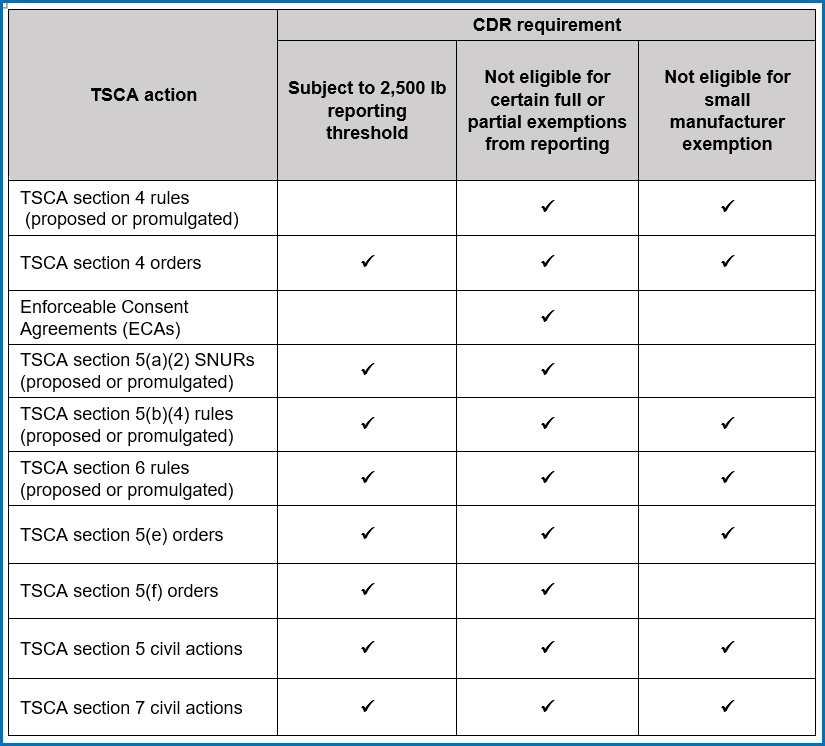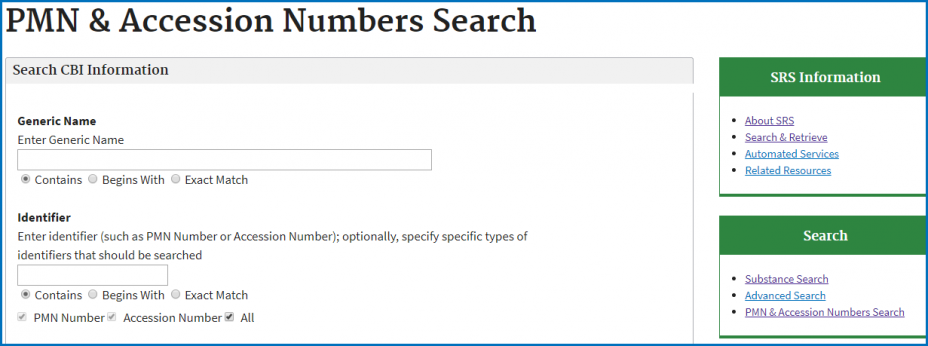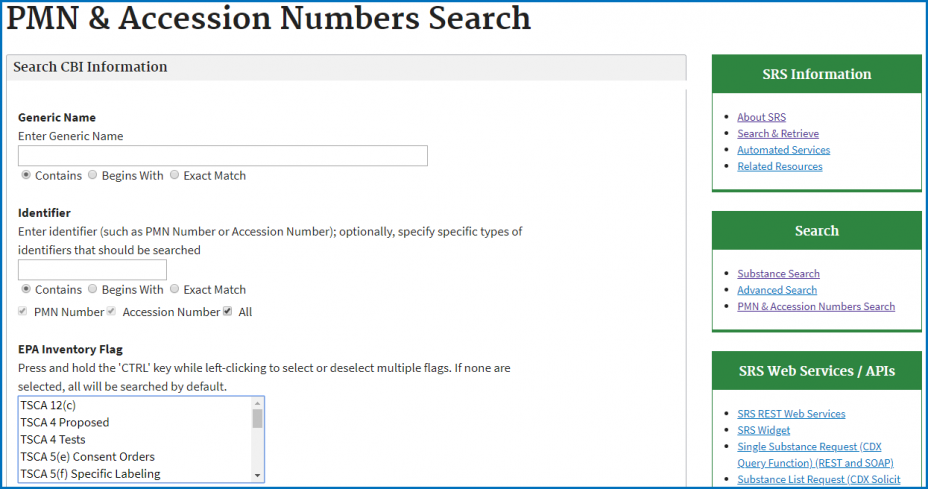Help with Chemical Data Reporting: How to Search for Chemicals Subject to Certain TSCA Actions
- What is SRS?
- How does the CDR reporting tool, e-CDRweb, use SRS?
- How do I search SRS for CDR-related information?
- How do I search SRS for chemicals identified with a CASRN?
- How do I search SRS for chemicals identified with an Accession Number?
- EPA 2020 CDR Chemical Status Spreadsheet
- TSCA Actions Table
- For further information
This document contains instructions on how to identify chemicals that are the subject of certain actions under the Toxic Substances Control Act (TSCA) using the Substance Registry Services (SRS).
This may be important to you because, when reporting under the Chemical Data Reporting (CDR) rule, manufacturers (including importers) must consider the effect of certain TSCA actions on reporting thresholds and their eligibility for certain exemptions, and the SRS contains information that you can use to identify whether your chemical substances are impacted.
For the 2020 CDR, you should check the status of your chemical substance(s) as of June 1, 2020, to identify whether your chemical substance is subject to CDR and the scope of your reporting obligation. Whether or not your chemical substance is subject to CDR depends on its presence on the TSCA Inventory at the beginning of a submission period. The scope of your reporting obligation may also depend on whether your chemical substance is the subject of a listed TSCA action as of June 1, 2020. If it is associated with a TSCA action, then that status could affect the reporting threshold or the availability of particular reporting exemptions that would otherwise apply (40 CFR 711.5, 40 CFR 711.6, 40 CFR 711.8(b), 40 CFR 711.9). You can identify whether your chemical is on the TSCA Inventory or the status of your chemical under certain TSCA actions by following the instructions below to search SRS or by viewing EPA’s 2020 CDR Chemical Status spreadsheet.
For more information also see TSCA Chemical Data Reporting Fact Sheet: Chemical Substances which are the Subject of Certain TSCA Actions.
The primary goal of this document is to help the regulated community comply with the requirements of CDR. This document does not substitute for that rule, nor is it a rule itself. It does not impose legally binding requirements on the regulated community or on the U.S. Environmental Protection Agency (EPA).
What is SRS?
The Substance Registry Services (SRS) is EPA’s central system for information about substances that are tracked or regulated by EPA or other sources. It is the authoritative resource for basic information about chemicals, biological organisms, and other substances of interest to EPA and its state and tribal partners.
How does the CDR reporting tool, e-CDRweb, use SRS?
When using e-CDRweb, submitters will be able to access SRS to add chemical identity information to their submissions. e-CDRweb uses an embedded SRS search function to access and search the SRS system. The embedded tool then populates selected chemical identity information into the CDR Form U. If your chemical is the subject of a TSCA action that potentially affects the scope of your reporting obligation, then the e-CDRweb reporting tool should identify it as such.
How do I search SRS for CDR-related information?
To search SRS for chemicals that are subject to certain TSCA actions, you can search for either a specific chemical or you can search for a list of chemicals related to a type of regulation or other characteristic that affects the status of a chemical related to CDR. For 2020 CDR chemicals, SRS has separated Chemical Abstract Services registry number (CASRN) searches from accession number searches; therefore, the instructions below show how to search CASRNs (individually and in a list) and accession numbers (individually and in a list) in SRS. Note that CDR submitters are ultimately responsible for adhering to a chemical’s reporting requirements based upon the status of the chemical in SRS on June 1, 2020, which is the first day of the CDR submission period.
How do I search SRS for chemicals identified with a CASRN?
To search SRS for an individual chemical with a CASRN:
- Type in a substance name or CASRN in the “Enter a name or number” field and select “Search.”
- Link to the chemical result that most closely meets your search needs.
- Under “Program and Regulatory Information / Statutes/Regulations,” be sure to look for chemical list titles that start with “2020 CDR” to see the statutes/regulations or other characteristics that affect reporting to the 2020 CDR.
To search SRS for a list of CASRNs associated with a type of regulation or other characteristic that affects the status of a chemical related to CDR:
- In the “Browse by chemical / substance lists” section, you can either scroll to locate the “2020 CDR” CASRN lists that impact 2020 CDR requirements, or you can isolate all of the 2020 CDR-related CASRN lists by typing “2020 CDR” in the “Filter all columns” box. The “2020 CDR” CASRN list titles follow, along with a description (if necessary) and the corresponding “TSCA Action” or other CDR characteristic. For more details, see the CDR document entitled “Fact Sheet: Chemical Substances which are the Subject of Certain TSCA Actions” or the TSCA Actions table.
- 2020 CDR TSCA Inv Active
- This is the list of chemicals listed by CASRN on the active portion of the TSCA Inventory that are considered active in U.S. commerce.
- 2020 CDR TSCA Inv Inactive
- This is the list of chemicals listed by CASRN on the inactive portion of the TSCA Inventory that are no longer considered active in U.S. commerce. A chemical’s inactive status is based upon its lack of reporting: (1) to the 2016 and 2012 CDR cycles; (2) in a Notice of Commencement received since June 21, 2006; (3) in a Notice of Activity Form A received through October 5, 2018; or (4) in a Notice of Activity Form B, per the TSCA Inventory Notifications (Active-Inactive) rule.
- 2020 CDR Full Exempt
- 2020 CDR Partial Exempt
- This is the list of chemicals listed by CASRN that are partially exempt from reporting under 2020 CDR, as long as they are not also found in certain TSCA actions. Manufacturers (including importers) of partially exempt chemicals are not required to report processing and use information, but are required to report basic identity and manufacturing information.
- 2020 CDR TSCA 4 TR
- This list contains chemicals listed by CASRN on proposed and final TSCA section 4 test rules, minus any of those chemicals that have a sunset date that occurs before June 1, 2020, which is the first day of the 2020 Chemical Data Reporting (CDR) submission period. The CDR rule under TSCA requires manufacturers (including importers) to provide EPA with information on the production and use of chemicals in commerce at certain quantities every four years, and the reporting requirements for the 2020 CDR are based upon the status of the chemical – e.g., if the chemical is included in a TSCA section 4 test rule – on June 1, 2020.
- This CASRN list corresponds to “TSCA section 4 rules (proposed or promulgated)” on the TSCA Actions fact sheet.
- 2020 CDR TSCA 4 Orders
- This CASRN list corresponds to “TSCA section 4 orders” on the TSCA Actions fact sheet.
- 2020 CDR TSCA 4 ECA
- This CASRN list contains chemicals in TSCA section 4 Enforceable Consent Agreements (ECA), minus any of those chemicals that have a sunset date that occurs before June 1, 2020, which is the first day of the 2020 Chemical Data Reporting (CDR) submission period. The CDR rule under TSCA requires manufacturers (including importers) to provide EPA with information on the production and use of chemicals in commerce at certain quantities every four years, and the reporting requirements for the 2020 CDR are based upon the status of the chemical – e.g., if the chemical is included in a TSCA section 4 ECA – on June 1, 2020.
- This CASRN list corresponds to “Enforceable Consent Agreements (ECAs)” on the TSCA Actions fact sheet.
- 2020 CDR TSCA 5(a) SNUR
- This CASRN list corresponds to “TSCA section 5(a)(2) SNURs (proposed or promulgated)” on the TSCA Actions fact sheet.
- 2020 CDR TSCA 5(e) Consent Orders
- This CASRN list corresponds to “TSCA section 5(e) orders” on the TSCA Actions fact sheet.
- 2020 CDR TSCA 5(f) Specific Labeling
- This CASRN list corresponds to “TSCA section 5(f) orders” on the TSCA Actions fact sheet.
- 2020 CDR TSCA 6 Unreasonable Risk
- This CASRN list corresponds to “TSCA section 6 rules (proposed or promulgated)” on the TSCA Actions fact sheet.
- 2020 CDR TSCA Inv Active
- Note also that several of the lists that were referenced in the TSCA Actions fact sheet – “TSCA section 5(b)(4) rules (proposed or promulgated),” “TSCA section 5 civil actions,” and “TSCA section 7 civil actions” – would affect reporting requirements for CDR, except for the fact that as of June 1, 2020, EPA has no chemicals associated with those regulations as of the date of these instructions.
How do I search SRS for chemicals identified with an Accession Number?
To search SRS for an individual chemical with an accession number:
- Visit the “PMN & Accession Numbers Search” webpage.
- Type in the generic chemical name in the “Enter Generic Name” field or type in the accession number in the “Enter identifier” field and select “Search.”
- In the resulting table’s “EPA Inventory Flag” column, be sure to look for chemical list titles that start with “2020 CDR” to see the statutes/regulations or other characteristics that affect reporting to the 2020 CDR.
To search SRS for a list of accession numbers associated with a type of regulation or other characteristic that affects the status of a chemical related to CDR:
- Visit the “PMN & Accession Numbers Search” webpage.
- In the “EPA Inventory Flag” section, select the specific type of TSCA action that begins with “2020 CDR” and select “Search” to generate the list of accession numbers associated with that 2020 CDR action.
Note: If your company is required to submit information under CDR and you expect to report a chemical using an accession number, please note that the confidential status of some substances on the TSCA Inventory is changing. Certain substances currently listed as confidential on the TSCA Inventory are expected to be disclosed on the public version of the inventory. EPA is posting a preliminary list of these chemicals by accession number to assist CDR reporters as they make decisions on CBI claims. The agency then plans to update the public version of the TSCA Inventory with these chemicals later this year.
The change in confidential status is due either to the fact that the claim was not reasserted as required in a Notice of Activity under TSCA section 8(b) or because the claim has been denied (because, for example, the substance was reported as non-confidential in a prior CDR submission or in a Notice of Activity). CDR submitters are encouraged to consult this list prior to filing 2020 CDR submissions and carefully consider confidentiality claims relating to these substances.
EPA 2020 CDR Chemical Status Spreadsheet
In addition to searching SRS to determine chemical status as it relates to TSCA actions, you can download EPA's 2020 CDR Chemical Status Spreadsheet(9 MB, September 22, 2020) which contains all of the TSCA Inventory chemicals (both active and inactive) and the TSCA actions that affect reporting requirements to the 2020 CDR.
TSCA Actions Table
Taken from: Fact Sheet: Chemical Substances which are the Subject of Certain TSCA Actions

For further information:
Access copies of additional fact sheets and other CDR information (www.epa.gov/cdr).
If you have questions about CDR, you can contact the TSCA Hotline by phone at 202-564-1404 or e-mail your question to eCDRweb@epa.gov.




